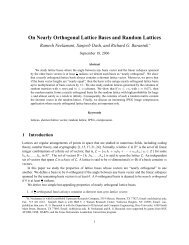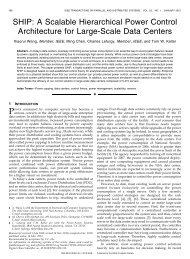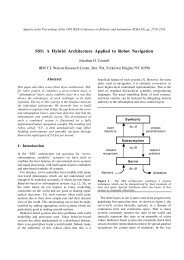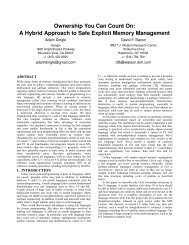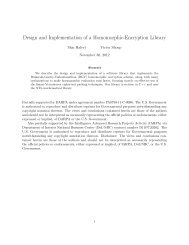Localized Supervised Metric Learning on ... - Researcher - IBM
Localized Supervised Metric Learning on ... - Researcher - IBM
Localized Supervised Metric Learning on ... - Researcher - IBM
You also want an ePaper? Increase the reach of your titles
YUMPU automatically turns print PDFs into web optimized ePapers that Google loves.
which c<strong>on</strong>firms the importance of leveraging label informati<strong>on</strong><br />
into the distance metric. We also observe that<br />
Wavelet features improve the performance significantly<br />
for LSML, where the classificati<strong>on</strong> error drops by half<br />
(from about 15% to less than 7%.)<br />
Table 1. Classificati<strong>on</strong> error comparis<strong>on</strong><br />
Expert PCA LSML<br />
Statistic features 0.2295 0.2131 0.1475<br />
Wavelet features NA 0.2295 0.0656<br />
Table 2. Precisi<strong>on</strong>@10 retrieval results<br />
Expert PCA LSML<br />
Statistic features 0.6120 0.5355 0.6557<br />
Wavelet features NA 0.5410 0.7869<br />
Sensitivity Analysis There are two parameters in the<br />
study: 1) the number of neighbors k in the k-NN classifier<br />
and 2) the dimensi<strong>on</strong>ality d of the resulting lowdimensi<strong>on</strong>al<br />
space (after PCA and LSML). Figure 3<br />
shows the reuslts of sentivity analysis <strong>on</strong> these two parameters.<br />
Figure 3(a) plots classificati<strong>on</strong> error vs. k for<br />
all methods. Small k leads to lower classificati<strong>on</strong> error,<br />
which c<strong>on</strong>firms the need for a localized distance metric.<br />
Figure 3(b) plots classificati<strong>on</strong> error vs. dimensi<strong>on</strong>ality<br />
d for all methods except Expert, which c<strong>on</strong>firms the<br />
stability of LSML w.r.t. to different d.<br />
6. C<strong>on</strong>clusi<strong>on</strong> and Discussi<strong>on</strong><br />
We have presented a method for deriving semantically<br />
sound similarity measures for retrieving patients<br />
represented by multi-dimensi<strong>on</strong>al time series. Our<br />
method uses both statistical and wavelet based features<br />
to capture the characteristics of patients, and leverages<br />
localized supervised metric learning to incorporate<br />
physicians’ expert domain knowledge. Experiments using<br />
the MIMIC II database dem<strong>on</strong>strates the efficacy of<br />
this appraoch. In future work we plan to explore ways<br />
to explicitly incorporate temporal characteristics of the<br />
data to further improve metric learning in this particular<br />
c<strong>on</strong>text.<br />
References<br />
[1] MIMIC II Database.<br />
http://physi<strong>on</strong>et.org/physiobank/database/mimic2db/.<br />
[2] X. Chen, D. Xu, G. Zhang, and R. Mukkamala. Forecasting<br />
acute hypotensive episodes in intensive care<br />
patients based <strong>on</strong> a peripheral arterial blood pressure<br />
waveform. Computers in Cardiology, 36, 2000.<br />
[3] I. Daubechies. Ten Lectures <strong>on</strong> Wavelets. SIAM,<br />
Philadelphia, 1992.<br />
(a) Stable with different k<br />
(b) Stable with different d<br />
Figure 3. LSML is stable with different parameter<br />
values.<br />
[4] K. Fukunaga. Introducti<strong>on</strong> to Statistical Pattern Recogniti<strong>on</strong>.<br />
Academic Press, San Diego, California, 1990.<br />
[5] J. Goldberger, S. Roweis, G. Hint<strong>on</strong>, and R. Salakhutdinov.<br />
Neighborhood comp<strong>on</strong>ent analysis. In NIPS, 2005.<br />
[6] Y. Jia, F. Nie, and C. Zhang. Trace ratio problem revisited.<br />
IEEE Transacti<strong>on</strong>s <strong>on</strong> Neural Networks, 2009.<br />
[7] M. Saeed and R. Mark. A novel method for the efficient<br />
retrieval of similar multiparameter physiologic time series<br />
using wavelet-based symbolic representati<strong>on</strong>s. In<br />
American Medical Informatics Associati<strong>on</strong>, 2006.<br />
[8] M. Sugiyama. Dimensi<strong>on</strong>ality reducti<strong>on</strong> of multimodal<br />
labeled data by local fisher discriminant analysis. J.<br />
Mach. Learn. Res., 8, 2007.<br />
[9] F. Wang, J. Sun, T. Li, and N. Anerousis. Two heads<br />
better than <strong>on</strong>e: <str<strong>on</strong>g>Metric</str<strong>on</strong>g>+active learning and its applicati<strong>on</strong>s<br />
for it service classificati<strong>on</strong>. In ICDM, 2009.<br />
[10] F. Wang and C. Zhang. Feature extracti<strong>on</strong> by maximizing<br />
the neighborhood margin. In CVPR, 2007.<br />
[11] E. P. Xing, A. Y. Ng, M. I. Jordan, and S. Russell.<br />
Distance metric learning, with applicati<strong>on</strong> to clustering<br />
with side-informati<strong>on</strong>. In NIPS, 2002.<br />
[12] L. Yang. Distance metric learning: A comprehensive<br />
survey. Technical report, Michgan State University,<br />
2006.




